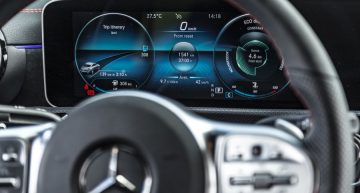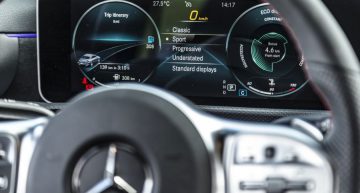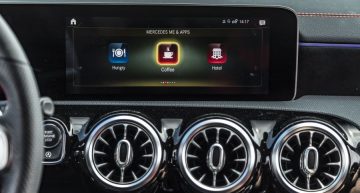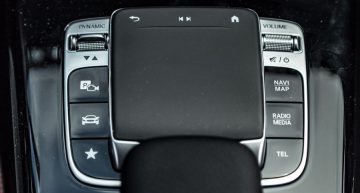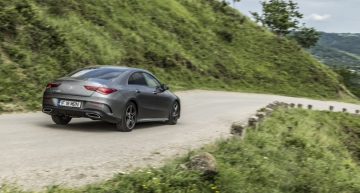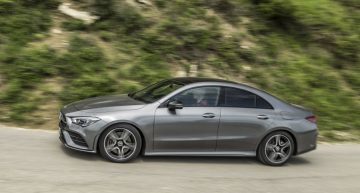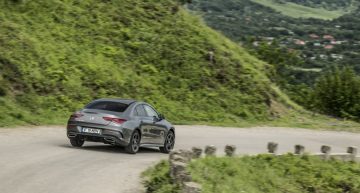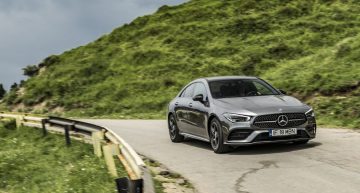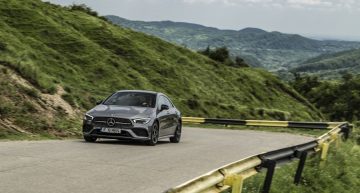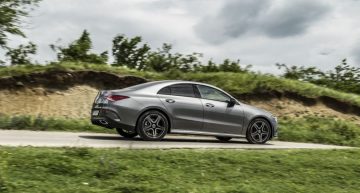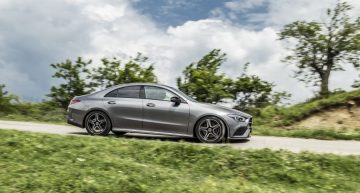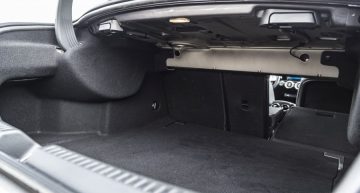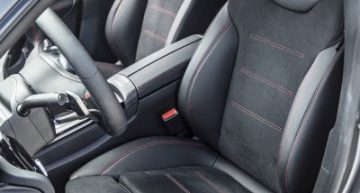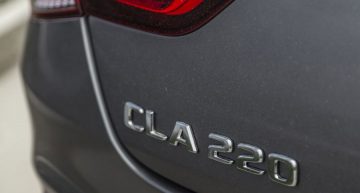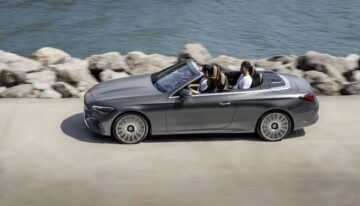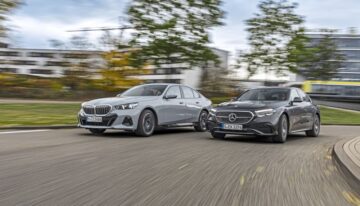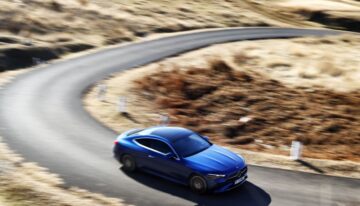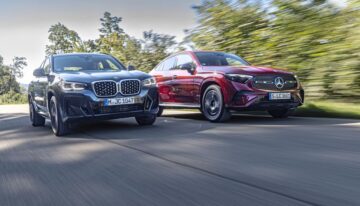The Mercedes CLA second generation comes with obvious pluses in terms of interior space, visibility, infotainment and assistance systems. We’re testing the CLA 220 with the 2.0-liter 190 PS turbo petrol engine, coupled to the 7G-DCT automatic transmission.
Photos: Bogdan Paraschiv
By launching the CLS back in 2004, Mercedes-Benz invented a new car species. The 4-door coupe earned quite many partisans, actually becoming a Mercedes-Benz trademark. Since then, many competitors have copied it in various segments and all succeeded with this body shape.
In 2013, Mercedes-Benz relapsed and proposed this body in the new compact class as well. ever since, the starred company sold no less than 750,000 CLA and CLA Shooting Brake units, and these two siblings managed to decrease the age average of the Mercedes-Benz customer. The extraordinary success is also explained by the fact that 50% of customers were newcomers to the German brand, coming from the competition.

The second generation was built on the MFA2 platform, derived from the one prior to it. It is not a completely new platform, but Mercedes changed quite many things: the tracks have widened at the front and at the rear by 63, 55 mm respectively, the wheelbase extended by 30 mm, the aerodynamics and the visbility improved and the new infotainment system MBUX was introduced in all second generation compact models.
The engine range is carried over from the A-Class, with four petrols and a diesel available at launch. The petrol range includes the CLA 180/CLA 200, both powered by the 1.3-liter turbo engine, built with Renault, with 136, 163 PS, respectively, coupled to the 6-speed manual transmission, and CLA 220/CLA 250, both with the Mercedes-sourced 2.0-liter turbo engine with 190, 224 PS, respectively, coupled to the 7G-DCT automatic transmission and available with 4Matic all-wheel drive.
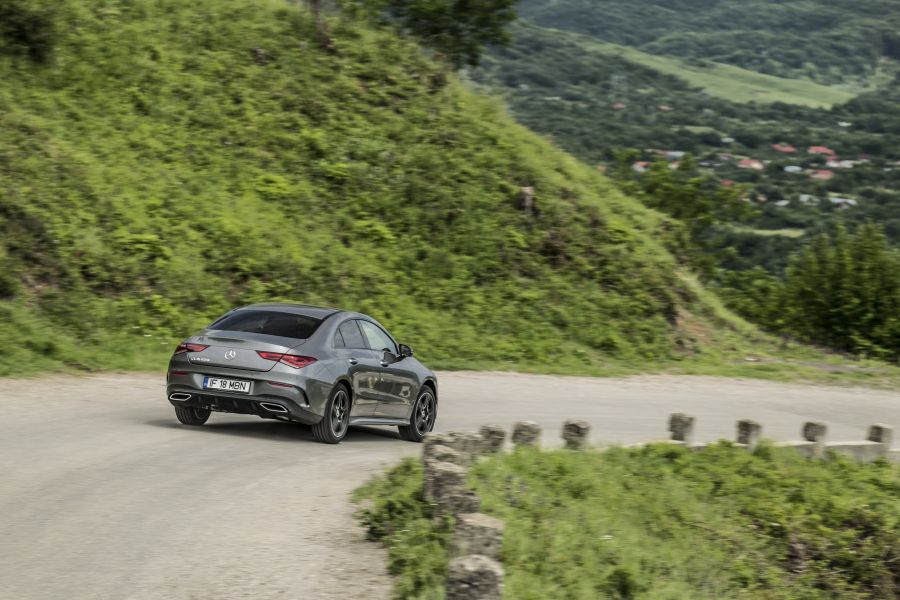
At the first meeting with the new CLA, we drove the CLA 220 variant with the AMG Line package (3,510.50 euros), that perfectly matches the sporty DNA of this 4-door coupe. AMG Line comes with sport seats with integrated headrests, multifunctional steering wheel covered in nappa leather, an aluminum insert in the dashboard central area in front of the passenger, 18-inch light alloy wheels, to which a sport exhaust, a lowered suspension and Direct Steer with variable reduction ratio are added. We thus have plenty of reasons to go for the AMG Line package, besides the more attractive exterior looks, with AMG front and rear bumpers and AMG side sills.
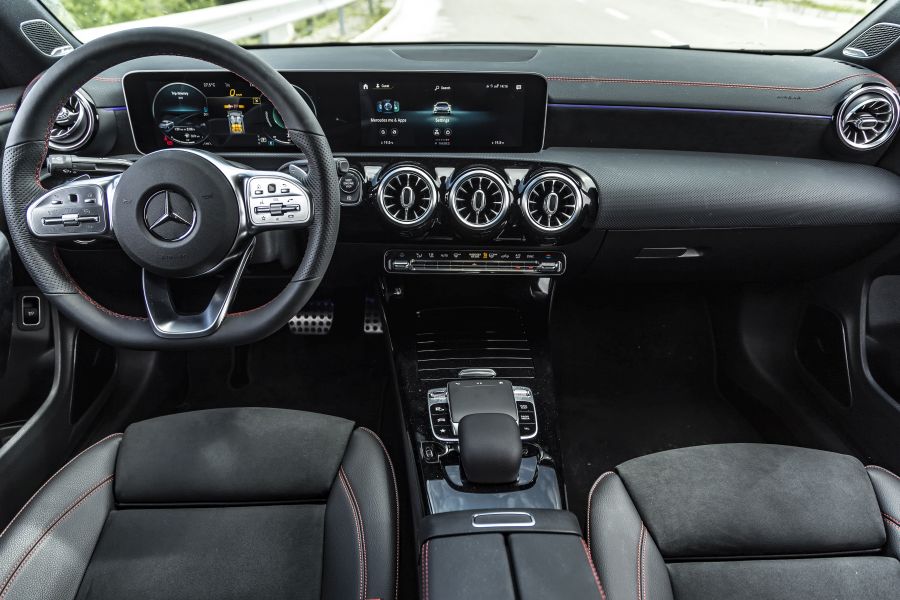
Firstly, like the A-Class, the comfort suspension lowered by 10 mm that is standard equipment in the AMG Line package, is the best of choices, because it offers the best of compromises.
- Progressing interior space
- Better visibility
- Top driving comfort
- Low noise level at high speeds
- Smart intuitive infotainment system

MAX vs MIN
- The seats with integrated headrests do not have the optimum shape
- Expensive infotainment system
- Non-ergonomic touchpad

Our test car was fitted with the optional adaptive suspension as well, allowing the selection between two driving modes: Comfort and Sport. With a reasonable price of 1,178.10 euro, the adaptive suspension box is worth ticking, because, in the Sport mode, is obviously stiffened, it reduces body roll and provides a sharper road behavior. And when you’re in search of comfort, you return to the Comfort mode and you enjoy the proverbial comfort of a Mercedes-Benz suspension for long drives on the highway. And the variable reduction ratio steering spontaneously responds and is extremely precise in the Sport mode.
When in a corners sequence, the CLA feels light and agile and the official weight of 1,490 kg is moderate. There was no such variant for the former generation, but only the CLA 250, powered by the same 2.0-liter turbo engine of 218 PS, that weighed 1.480 kg. Thus, despite the light exterior length and width growth, the new CLA is a bit lighter than the former one.

Upon driving on the highway, the CLA 220 is worth of the more expensive Mercedes models with rear-wheel drive. The general noise level is reduced, the drivetrain is very quiet and the wind noise is also very low thanks to an exceptional aerodynamics (Cd = 0.23), despite the fact that the windows are frameless.
The CLA drives just as comfortably as a C- or an E-Class and the passengers may converse without raising their voices even at speeds of 170 km/h. The 2.0-liter turbo engine is the ideal choice for the CLA, because the 4-door coupe is more massive than the A-Class.
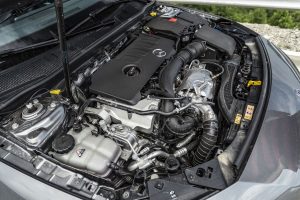
And for the A-Class, we found that the new 1.3-liter turbo engine, built with Renault, and the new 7G-DCT gearbox supplied by Getrag do not make the merry couple expected. Therefore, the best choice for the CLA is a 100% Mercedes-sourced engine and gearbox. The 7G-DCT symbol may mislead you, because it is the exact same designation for the automatic Mercedes gearbox and the Getrag unit.
The Mercedes compact range holds three gearboxes: the Getrag 7G-DCT for the 1.3-liter petrol turbo and 1.5 diesel engines made in cooperation with Renault, the 7G-DCT produced by Mercedes and used in the previous generation as well, for the Mercedes 2.0-liter turbo engines, and the 8G-DCT, produced by Mercedes for the new 2.0-liter diesel.
In the Sport mode, the gearbox shifts swiftly and we must point out the superb sound when the transmission downgrades several gears. The 300-Nm torque is not that huge, but it is available from 1.800 rpm and the engine vigorously pushes forward the car that is no heavier than 1.5 tons.
With wider tracks and with a good weight distributions for a front-wheel drive car, the CLA does not understeer too much and offers a very delightful driving experience. The petrol engine matches the 4-door coupé spirit, especially because you get to enjoy the sporty sound of the exhaust, but you must consider a consumption of approximately 10 l/100 km.
The new CLA is not only attractive in terms of driving, but also in terms of looks. The new lowered shark nose grille and the headlights running downwards to the grille, as well as the long hood with the two powerdomes, provide it with a dynamic look. At the rear, the 2-piece elongated taillights give it the appearance of a pure-blooded GT.
Inside, we point out the MBUX infotainment system with the two 10.25-inch displays that look gorgeous and feature an iPad-like resolution, but that do not come cheap: 3,016.65 euro cost the Premium Navigation package, plus 297 euros more for augmented reality.
There is a lot of money, but they are worth it, because you are thus able to set the indicators display in several modes, because each mode – Sport, Progressive, Classic, Understated and Standard – features five different themes. Then the infotainment display may be controlled via the touchpad on the steering wheel, via touch control, voice control and the generously sized touchpad.
Even though more precise than that of the Lexus, the touchpad solution is not better than that of the classic controller, but you get three other modes as well. You engage the system by uttering „Hey Mercedes”, then speak out “I am hungry” and it finds a restaurant in the area. Or you say “I need a hotel” and it displays the closest hotels accompanied by the reviews on tripadvisor.
The interior is also a big step forward, because at the rear, there is significantly more kneeroom, even though on paper, the kneeroom only extended by 1 mm. The headroom is largely the same, meaning that the people who are 1.80 meters tall will reach the roof with their head if the sunroof should be ordered.

A major progress is accounted by visibility. The new extra-large 10.25-inch displays are now flatter and the windshield is not as flat as it used to be, so that at the front, the visual field is wider and you escape the claustrophobic feeling. Visibility backwards is obviously better.
The driving position is quite low and the sport seats in Alcantara leather provide very good support, but the solution with the integrated headrest is not the best. Tall people do not get the perfect support in the area of the back of the head. The boot volume of 460 liters is 10 liters smaller, but we appreciated the opening wider by 26 cm, thanks to the new two-piece taillights and the 40/20/40% foldable rear seats, allowing the load of longer objects.
Below 40,000 euros for the CLA 220 with automatic transmission is a quite reasonable price and, with the AMG package, it goes as high as approximately 40,600 euros. With the optional infotainment system, assistance system and electrically adjustable seats, the price goes towards 50,000 euros. But what other 4-door coupe you could buy with for the same price?

Verdict
The new Mercedes-Benz CLA is not just a car as good-looking as its predecessor, but also more practical. The driving comfort is much better and the noise level has decreased . The new infotainment system is spectacular and efficient and the 100% Mercedes-sourced 2.0-liter turbo engine is the optimum choice. If you choose the CLA, then choose a 100% Mercedes-Benz engine and gearbox. You will thus fully enjoy the qualities of a genuine Benz.
| Technical data | Mercedes |
|---|---|
| Model | CLA 220 7G-DCT |
| Engine/no. of cylinders | L4, turbo |
| Displacement (cmc) | 1,991 |
| Max. Output/revs (HP/rpm) | 190/5,500-6,100 |
| Max. Torque/revs (Nm/rpm) | 300/1,800 |
| Transmission | fwd |
| Gearbox | 7 gears, automatic |
| L/w/h (mm) | 4,688/1,830/1,439 |
| Wheelbase (mm) | 2,729 |
| Boot volume (l) | 460 |
| Kerbweight (kg) | 1,490 |
| Acceleration 0-100 km/h (s) | 7.0 |
| Top speed (km/h) | 241 |
| Fuel consumption urban/extr./mixed (l/100 km) | 8.0/4.8/6.0 |
| CO2 emission (g/km) | 138 |
| Price (euro with VAT) | 37,139.90 |


